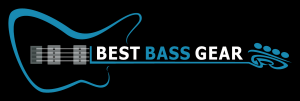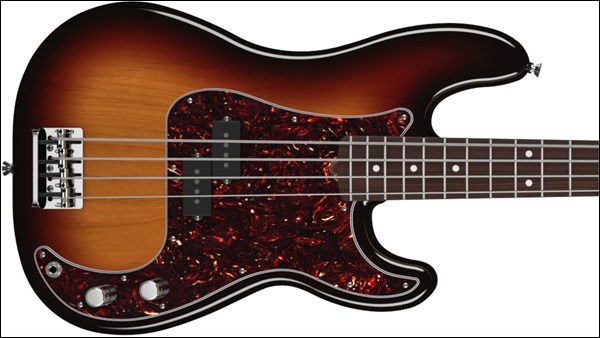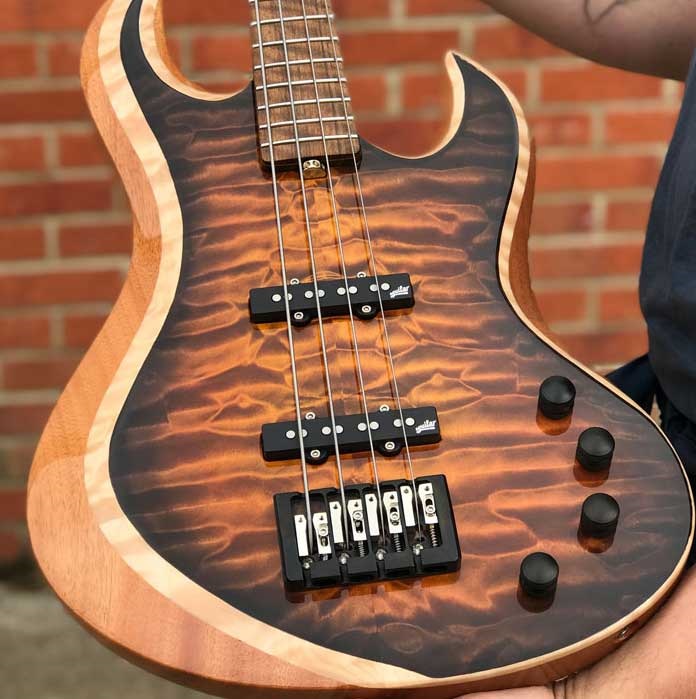A big reason why so many bass players are fond of the Fender Precision Bass and Fender Jazz Bass designs (even when not made by Fender) is because those models do not have what’s known as “neck dive.” Neck dive happens when you strap on a bass guitar, and the headstock immediately leans toward the floor, requiring you to physically hold up the instrument with your fret hand.
An example of a bass guitar with what some consider to be horrendous neck dive is the Gibson SG bass:


But why would the SG bass have neck dive while the Precision and Jazz wouldn’t?
Most players would guess that the headstock must have been designed too heavy or the body not heavy enough. Those can be factors, but the main reason for neck dive on the SG bass is that the top horn of the body does not extend to the 12th fret of the neck, and the strap button is nowhere near the 12th fret either.
On traditionally styled bass guitars (meaning the kind without any experimental wacky designs,) if the top horn of the body does not go over the 12th fret of the neck, and the fret-side strap button isn’t near the 12th fret either, it is safe to assume the bass guitar will probably have neck dive problems.
Another bass guitar infamous for its neck dive is the B.C. Rich Warlock bass:


Again, you see that the top horn does not get anywhere near the 12th fret, and neither does the strap button. While not all Warlock bass guitars have neck dive issues, many of them do.
Hipshot Ultralight tuners can help to cure neck dive along with a wide guitar strap.
And then there is the counterweight method, which is something you can make yourself fairly easily – but bear in mind that this video concentrates mainly on seated-position playing:
Do all bass guitars without a fret-side strap button near the 12th fret have dive problems?
No. There are some designs that successfully avoid neck dive even with the fret-side strap button not near the 12th fret.
However, when shopping around for a bass guitar, paying attention to the top horn (if the bass has one) and fret-side strap button position is important. If you see the top horn doesn’t extend over the 12th fret, and the fret-side strap button isn’t near the 12th fret either, play the bass strapped on in standing position before purchase just to make sure the neck dive isn’t there. If it is, you’ll know why.
And now you also know why many custom bass guitar designs have a long top horn. It’s specifically to balance the instrument while playing in standing position.




My Guild B-301 had horrible neck dive…shame, it was a lovely bass.
Yes, but the ultralights do help this one a lot. Orignal tuners over 1 pound!
Neck dive is one thing I don’t have to worry about with my Hofner Icon!
Warwick thumb! Worst neck dive ever
Totally agree!!!
Yes, it is one of the worst neck-diving instruments I’ve ever played. But, that sound!
Before that video I never heard anyone complain about neck dive while seated.
Hofner Beatle bass?
The absolute worst neck-dive offender, in my experience and opinion.
I always thought the Explorer style guitars would be awesome for avoiding neck dive. With the larger piece of wood coming up in the back it always to me seemed a good counter balance to whatever the neck was doing.
Not having owned one I do not know for sure, can anyone shed any light on that?
My Hamer Blitz (explorer style) does not dive, and it has a long headstock.
the punisher is designed to dive to parallel! So cool when you let go of it.
I had a Gibson EB-0, it’s like an ES335 and I didn’t notice this.
I’ve got a 72 Jazz Bass with an axtra aftermarket neck made of bubinga and it suffers from neck dive!
The lack of neck dive is one of many reasons I love my Matt Pulcinella Guitars Level 5 – It balances perfectly due to the extended horn. If you’ve never played one, you’re missing out – Richard Dabbs.
One of the big problems with the Guild was that the tuners weigh over 1 pound. Ultralights make these a lot more playable.
But why adding weight on a bass ? Maybe it is simple as buy a better designed instrument. Just saying
I am a beginner, was always interested in the bass, picked up a Warlock cheap to learn on, dives so bad can only play sitting down with my leg locked in the rear V on the body
19.72 Gibson EBO…..Mr Neck Dive! replaced tuner with hipshot ultralight tuners…better, but not prefect.
Main reason why I will NEVER own another Thunderbird or ANY Gibson bass for that matter.
One can’t play a bloody thing very well if one’s left hand is primarily just trying to hold the neck up.
I have 6 Thunderbirds and none suffer from neckdive. Only thing I have done is use a strap with a rough back (suede) and no dive.
Every Thunderbird bass neckdives. Your rough suede strap just puts the pull on your shirt. But, if you don’t want your shirt disheveled looking all night, you constantly have to readjust the suede strap. Thunderbirds, and every other Gibson bass, are designed moronically – PERIOD.
the new thunderbirds dont dive at all….the headstocks are smaller and they use much smaller tuners,my gibson midtown standard also has no problem with neckdive
Both those basses inherently neckdive. Sorry, but I think you’re oblivious to what constitutes neckdive to most experienced bass players.
My F-Bass has an extended upper horn and neck dive is not a problem.
Spector basses are great and do not follow the 12th fret rule
Some Fender Jazz basses have this problem when played in a seated position. The semi hollow Fenders have serious neck-dive. Some Gibson and Epiphone basses do have this issue. There are work-arounds but it requires relocation of strap buttons. Management of the relationship of the scale length and the location of the bridge vs the nut helps. A bridge near the tail brings the nut closer to your fretting hand shoulder. This results in a shift in mass for the bass. Also, for custom basses, upper bout proximity of the strap button very close to the neck helps.
Neck dive is only half of the short-upper-horn problem. My first bass was a Washburn Scavenger. Symmetrical body, upper horn (& strap button) over the 17th fret. It looked way cool, but the neck dive was a hassle and reaching the 1st fret strained my wrist. I build my own basses now, with the upper “horn” (they’re singlecuts) over the 10th fret. Very comfortable and easy to play.
My Fender Jazz Special (Duff style bass) neck dives more than normal. Never had that with a “P” style bass before. None of my Thunderbirds dive either, but they have the strap button on the back of the body and I use a leather strap with the suede feel on the back and that solves it for all of my basses, except the 8 string.
back in the day, we would put the strap on the headstock with the EB-3, just like the old school acoustic straps, just need a shoe lace, but I’m sure someone makes a strap adapter that will make it balance perfect, I have used this on many top heavy basses and it works great, adding weight would never work with my back!
I play a hollowbody bass and wedge the bout under my right forearm and use a suede strap. I’d prefer a J-bass but they feel too slippery. Like a suppository!
Strap to headstock cures all your ills. Otherwise a broad and grippy strap will help.
Yea, but it makes you look like Jethro Bodine on stage.
I played a Hofner bass once. Never again. By the end of one song, my arm was aching from having to support the weight of the neck, and it was extremely difficult to move my hand up and down the neck. It was horrible!
I have a Lakeland 4401 skyline neck dive is nonexistent as with all Lakelands well balanced basses and the tones you get withe the Bartolini pickups